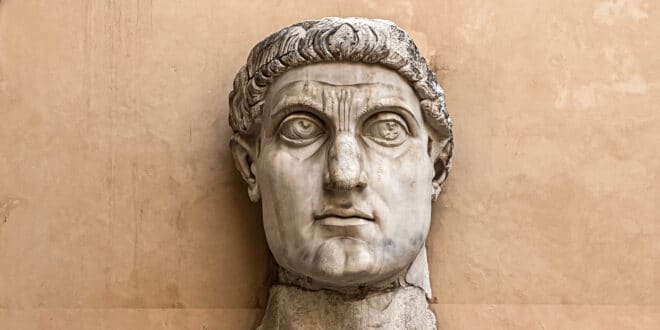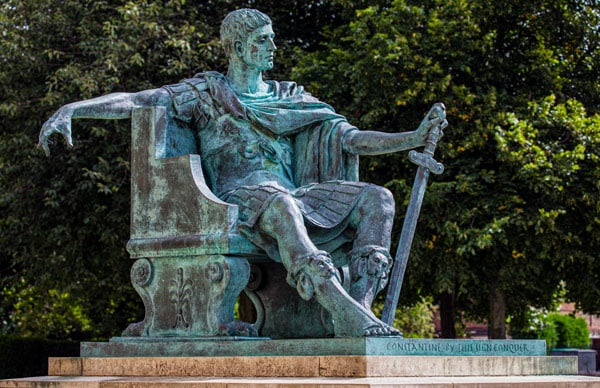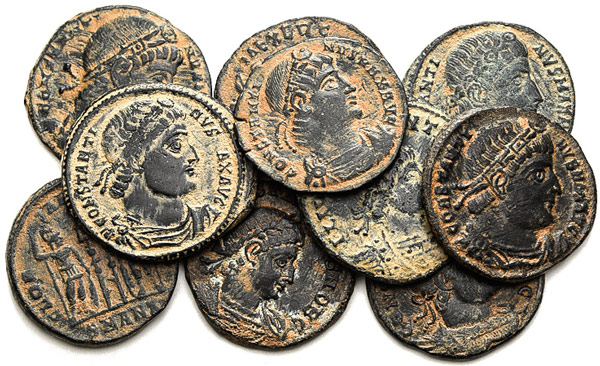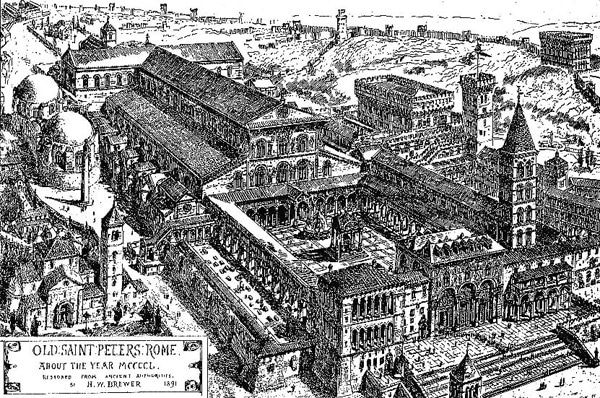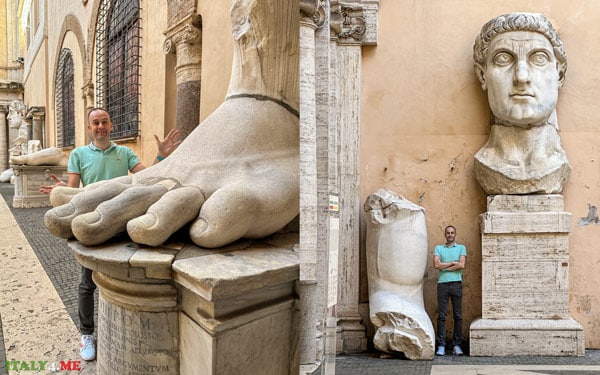Flavius Valerius Aurelius Constantine, known as Constantine I and Constantine the Great, was an eminent Roman Emperor from 306 to 337 AD. His activities left a significant mark not just in the history of Ancient Rome, but also on humanity as a whole, changing the lives of millions. He was the first ruler to adopt Christianity and make it the predominant religion. Although Constantine was baptized only on his deathbed, he managed to understand and embrace the principles of the Gospel during his lifetime. The Orthodox and Roman Catholic churches venerate him as a saint in the rank of the Apostles.
The history of New Rome – Constantinople, a city that remained a spiritual and cultural center of the Christian world for a thousand years, is closely associated with the emperor’s name as its founder.
Page Contents
Family
Constantine was born between 271 and 275 AD in Naissus, in the Roman province of Upper Moesia (modern-day Niš, Serbia). His father was the future Emperor Constantius I Chlorus. At that time, he had already carved out a career in the army and made a name for himself in politics. Constantine’s mother, a Greek woman named Flavia Julia Helena, originated from Drepana (in modern Turkey) and came from a modest background. She was the daughter of an innkeeper and assisted her father in serving wine. She met Constantius, and subsequently, the couple began living together. Due to their different social backgrounds, Helena remained a concubine, an official mistress. Cohabitation was not forbidden in the Roman Empire at the time; moreover, a woman and her child had certain rights regarding inheritance. In 293 AD, Constantius left Helena, as he was compelled to marry Flavia Maximiana Theodora, the stepdaughter of his benefactor, Emperor Maximian, for his career.
It should be noted that Constantine’s father continued to take care of his firstborn and saw him as his successor.
Helena remained at the court of Constantius and later at the court of her son, playing a crucial role in the spread of Christianity.
Constantine had three half-brothers on his father’s side (Dalmatius the Elder, Julius Constantius, Hannibalian) and three sisters (Anastasia, Constantia I, Eutropia II).
Youth
Following the separation of Constantius I Chlorus from Helena, there is scant information about Constantine’s life. He rarely saw his father, who was continually engaged in military campaigns alongside the emperor.
From the age of 17, Constantine resided at the court of Diocletian in Nicomedia (present-day İzmit, Turkey). He was effectively a hostage there, being the potential heir of his father, who was proclaimed Caesar in 293 AD after a successful career.
Constantine mastered military science, honed his horse-riding skills, and delved into Latin literature, philosophy, and Greek. He also showed interest in Christianity, attending lectures by proponents of the new religion. Several years at the emperor’s court also taught Constantine the rules of etiquette, diplomacy, and the art of survival amidst court intrigues.
Between 295 and 303 AD, the future emperor gained military experience, following Diocletian to Egypt, participating in Galerius’s campaign against the Sassanids, and battling the Sarmatians along the Danube.
In 303 AD, Constantine returned to Nicomedia, coinciding with Diocletian’s most severe persecutions of Christians. Historians contend that Constantine did not partake in the persecutions and destruction of churches, nor did he oppose the oppressions of believers. Yet, these dark events profoundly impacted Constantine’s soul.
Interesting Information:
A unique parallel connected the future emperor with his contemporary, the great martyr Saint George the Victorious. Saint George underwent horrific tortures and was executed on April 23, 303 AD, in Nicomedia, possibly in Constantine’s presence. Later, in 330 AD, the emperor established the first order in history and named it after Saint George in memory of the saint. The award was given to the most devoted advocates of Christianity. After the emperor’s death, this distinction was called the Order of Constantine’s Saint George, and in the 12th century, it was known as the Order of Constantine the Great.
Another important event occurred during this period of Constantine’s life. He repeated his father’s fate by engaging with a woman named Minervina. She was of Syrian descent and possibly a Christian. Presumably, in 305 AD, a boy named Crispus was born from this union. After Minervina’s death, Constantine cared for the child’s upbringing and later facilitated his career advancement.
Proclamation as Emperor
In 305 AD, Constantine was called by his father, Constantius I Chlorus, who had become the emperor of the western part of the Roman Empire. At that time, the state was governed by a tetrarchy. There were four emperors in power – Augusti Diocletian and Maximian, as well as their appointed Caesars Constantius, who was then the prefect of Gaul, and Galerius. When the senior rulers abdicated, the western and eastern parts of the Roman Empire were divided among their younger successors. Galerius, longing for complete power, hoped to gain it after the death of Constantius, who had become weak in health.
The support of the army played a crucial role in the selection of a ruler. When Constantine arrived at his dying father’s side in Britain, the army embraced him, preferring dynastic succession within a familiar family. In 306 AD, after the death of Constantius I Chlorus, the legions proclaimed his son emperor. This event took place in Eboracum (now York, Great Britain).
Fearing the loss of power and under the pretext that Constantine was still too young, Galerius allowed him to be only a Caesar, appointing his own nominee, Flavius Severus, to the position of the deceased Constantius.
Struggle for Absolute Power
Having become emperor, Constantine remained in the Roman province of Gaul (the territory of modern France). He had the full support of the army and the local population, who remembered his father’s gentle and fair policies. The young emperor was subordinate to Flavius Severus, who was not very popular among the Romans.
The battle for power was still to come. There were enough contenders for sole rule, and none wanted to submit to another.
Maxentius’s Rebellion and the Death of Flavius Severus
In Rome, due to the uprising in 306 AD, Maxentius, the son of the abdicated Maximian, came to power. Constantine took his side, hoping to end Flavius Severus, who tried to besiege the empire’s capital and suppress the revolt. After unsuccessful attacks on Rome, Severus retreated to fortified Ravenna. Maximian, having returned to power, cunningly persuaded Severus to surrender, promising to spare his life, but later forced him to commit suicide.
In 308 AD, by the will of Emperor Galerius, Licinius received the place and title of the deceased Severus. In the same year, Galerius was forced to proclaim Constantine as Augustus, maintaining his equal status with Maximian, who had previously declared himself Augustus. Thus, five emperors governed the Roman Empire simultaneously, and there was no friendship between them.
Maximian’s Betrayal
In 310 AD, Maximian, who had turned away from his son, joined Constantine and even moved to him in Arles (modern Arles, France). But as soon as Constantine left for a campaign against the Franks, Maximian betrayed him, spreading rumors of his death. Constantine was forced to return and restore order. As the army was on his side, Maximian had no chance. He fled to Massalia (today’s Marseille), but the locals handed him over to Constantine. Maximian chose his form of execution and was hanged.
Battle with Maxentius
The battle with Maxentius for power entered history as the Battle of the Milvian Bridge. This time, it was Constantine who took the initiative. The Romans wished to be rid of the cruel tyrant Maxentius had become. Constantine chose the time when the city was celebrating the ruler’s birthday. Despite Maxentius’s large army, Constantine won several battles due to the element of surprise. The final battle took place at the Milvian Bridge. The enemy’s army could not withstand the onslaught and fled, while Maxentius, in fear, threw himself into the Tiber and drowned.
Constantine’s Triumphal Arch
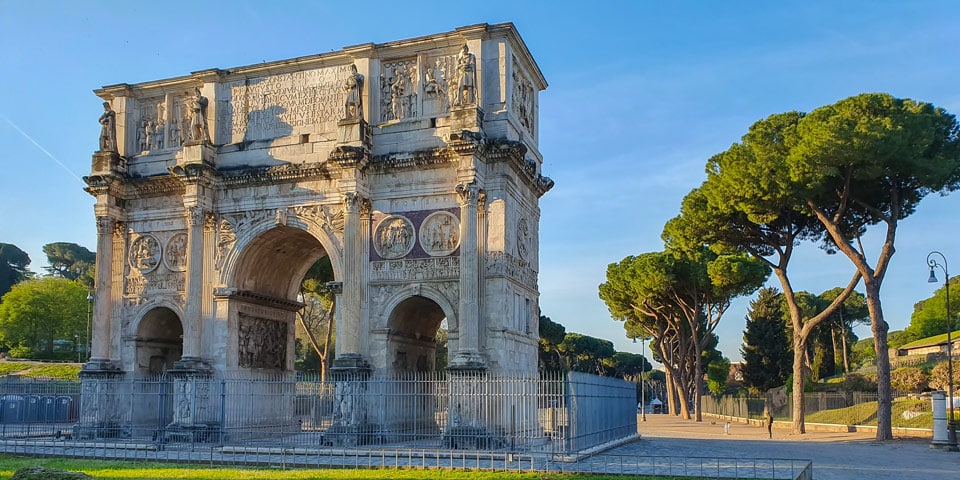
The Vision of the Cross
The Battle of the Milvian Bridge is also famous for another event that has been recorded in Christian history. On the night before the battle, Constantine saw a Cross in the sky and heard a voice with the blessing “In hoc signo vinces,” which translates to “In this sign, you will conquer.” In the morning, the image of the Cross appeared on the shields of his warriors, who then achieved a glorious victory.
After this event, Constantine ordered the creation of the labarum – a sacred banner with the monogram of Jesus Christ on the staff and the inscription “In hoc signo vinces” on the canvas. Constantine selected 50 of his best warriors to guard this new military standard, who were called crusaders and always followed him into battle.
War with Licinius
Constantine still did not possess full power in the empire; he only controlled part of it – Gaul, Italy, Africa, and Spain. He needed to eliminate two more competitors to gain the remaining provinces in Asia, Egypt, and the Balkans.
In 313 AD, Licinius defeated Maximinus Daia in battle and seized a large part of the empire.
Constantine had to fight with the surviving rival more than once. In 324 AD, a naval battle at the Hellespont and the Battle of Chrysopolis put an end to the dual power. The pardoned Licinius was sent into exile in Thessaloniki, where he was soon killed under mysterious circumstances.
Marriage
Constantine entered into an official marriage as emperor in 307 AD. His chosen one was Fausta Maxima Flavia, the daughter of Maximian, who was 15 years younger than her future husband. She was noted for her beauty, nobility, and high moral qualities. Fausta bore Constantine’s three sons (future Caesars Constantine I, Constantine II, and Constans II) and three daughters (Constantina, Helena, and Fausta). The emperor respected his wife, significantly after she helped expose her father Maxentius’s conspiracy. In 324 AD, Fausta received the title of Augusta, but just two years later, she became a victim of a family tragedy.
In the summer of 325 AD, Constantine executed his own son from his first marriage, Flavius Julius Crispus, for having an affair with his young wife Fausta. Later, upon discovering his wife’s deceit, who had slandered to clear the way to power for her sons, the emperor killed her too. He locked her in an excessively hot bath, where she suffocated from the heat.
The emperor understood that the pagan gods would not forgive him for the murder of close people, and only Jesus Christ is merciful to repentant sinners. It is believed that the deaths of Crispus and Fausta were among the reasons for Constantine’s adoption of Christianity.
Reign
On September 18, 324 AD, Constantine was officially declared the sole ruler of the Roman Empire. His path to power during 20 years of civil war was bloody, and the victims were not only his co-rulers. Constantine also dealt with most of his friends, fearing conspiracy. Nothing could now hinder the realization of the emperor’s plans, who, by his own words, was led by God Himself.
Constantine began transforming the empire as early as 306 AD, when he assumed the title of Caesar. Over 30 years of rule, he “broke” the laws of the old Roman Empire and laid the foundations for the future structure of the Christian world.
Reforms Conducted by Constantine
Constantine’s political, military, and economic reforms did not bring prosperity to the state, but they did ensure internal stability and secured the borders of the Roman Empire.
Significant transformations affected the administrative and legal system. It consolidated absolute power (dominate) in Constantine’s hands over the entire territory of the Roman Empire, including the East, Illyria, Italy, and Gaul.
Monetary Reform
The monetary reform restored the Romans’ lost trust in coins made of precious metals.
The gold solidus introduced by Constantine remained in circulation until the fall of the Byzantine Empire (over seven centuries), and the new monetary system laid the foundation for future financial relations among the states of Europe.
Military Reform
The military reform reorganized the structure of the Roman army and strengthened discipline control within it. Legions, previously concentrated mainly on the border, were redistributed to create maneuverable forces of infantry and cavalry. These were led by commanders who acted only under Constantine’s direct control.
Military positions were no longer combined with civilian roles and could be passed down by inheritance. These and other measures eliminated the possibility of using the army to seize power and generally strengthened the military potential of the Roman Empire.
Tax Reform
The tax reform tied citizens and peasants to their place of residence, ensuring control over Roman incomes and stable treasury replenishment. In essence, this changed the status of land tenants to serfs, laying the foundation for the structure of future European society.
The scale of transformations conducted by Constantine in the state was immense, but his main reform – the religious reform – changed the world.
I also recommend reading about Ancient Roman coins.
Religion – Ending the Persecution of Christians
Constantine became the first emperor to stop the persecution of Christ’s followers and legalize the new religion. What led him to Christianity? Ideological conviction, providence, or cold calculation?
Jupiter was the official deity of the tetrarchy, while Constantine, longing for absolute power, sought his god-patron. Religion could become for him the main tool to achieve his ambitious goals — a people united by one faith are easier to govern.
He was still a pagan when he conducted the most important religious reforms. A foundational date in Christian history is June 13, 313 AD – the day Constantine signed the Edict of Milan (Edictum Mediolanense). This document proclaimed freedom of worship for all Romans and returned churches and property to Christians that had been taken from them during the persecutions. The emperor established a primary norm in religion, still in effect today: “In matters of faith, everyone should follow the dictates of their heart.”
In 325 AD, under the presidency of Constantine, the first ecumenical council in the history of Christianity, the Council of Nicaea, was held. It established canons that defined the main postulates of the Christian church for the following centuries. Non-acceptance of the Council’s decisions was declared by Constantine as treason, undoubtedly influencing the unification of the empire in a single faith.
The Role of Mother Helena
Constantine I’s religious policy is inextricably linked with his mother’s name, who is also venerated as a saint among the Equals to the Apostles. Influenced by her son, Helena converted to Christianity at about 60. She dedicated the rest of her life to pious activities in search of divine places and relics. The emperor provided her with every assistance and spared no expense for her travels and philanthropy. During a pilgrimage to Jerusalem, Helena organized excavations at Golgotha and discovered the prominent relics associated with the Passions of Christ.
Believers around the world owe Constantine I and his mother Helena, the discovery of the Life-Giving Cross, the construction of the Church of the Holy Sepulchre, the Basilica of the Nativity in Bethlehem, and the appearance of many other magnificent churches built by the command of the great emperor. By the way, Constantine returned to Jerusalem its old name, replacing Aelia Capitolina, which had been introduced by Emperor Hadrian.
Charitable Acts
Until his death, Constantine remained a pagan, yet he patronized Christianity throughout his life and largely followed its commandments. The emperor’s benefactions included building churches, producing liturgical books, generous donations, helping the poor and orphans, and enacting new humane laws.
The emperor financed the construction of churches in the Holy Land and all regions of his empire, including the capital. In 326 AD, the Basilica of Saint Peter, the same “old” basilica that stood from the 4th to the 16th centuries at the site of the modern St. Peter’s Basilica (Basilica di San Pietro), was erected in Rome.
In 312 AD, Constantine gifted the palace of his wife Faustina, located on the Lateran Hill, to the Roman bishop. Reconstructed into the Basilica of St. John Lateran (San Giovanni in Laterano), this palace remained the papal residence until 1308 AD.
Constantine’s new approach to the individual as a person was reflected in the legislative acts he issued. They aimed to strengthen the family and spread Christian values in society. Here are some of them:
- Banning of gladiatorial fights, pagan rituals, and visiting temples of old gods;
- Ending punishments by crucifixion;
- Introduction of a weekly day off — Sunday;
- Penalties for kidnapping girls and violence against them;
- Prohibition of adultery and keeping concubines in homes;
- Banning the separation of slave families,
- Provision for the emancipation of enslaved people by declaring it in a church.Particularly striking was Constantine’s ban on branding the faces of convicts with hot iron. He believed that the human face, created in God’s image, reflects heavenly beauty.
New Rome
A new era in the history of Rome was marked by the relocation of the capital. Constantine had long dreamed of this. While Rome’s prestige remained high, it was no longer the center of the world. The emperor himself only visited the capital a few times: during his triumph after the battle with Maxentius and then twice more.
Constantine’s choice for the new imperial capital fell on the ancient Greek city of Byzantium (today Istanbul), located on the shores of the Bosporus, at the junction of Europe and Asia, West and East. In 324 AD, work began on the reconstruction of the old city, and just six years later, on May 11, 330 AD, the emperor announced the New Rome.
The architecture of the City of Constantine received a Christian imprint, and traces of the previously existing pagan idolatry were completely erased.
The only temple completed during Constantine’s time was the Church of the Holy Apostles, also known as Apostoleion. The emperor built it to house the relics of the twelve apostles and as a family mausoleum. It was the most beautiful building in the city until the appearance of the Hagia Sophia. The exterior of the Church of the Holy Apostles can only be judged by descriptions and a few ancient images.
By the way, the Basilica of St. Mark (Basilica di San Marco) in Venice closely resembles Constantine’s Apostoleion and contains some elements of its decor. Currently, the Fatih Mosque stands on the site of the Church of the Holy Apostles.
Last Years of Life
Constantine spent his last years in battles with the Goths and Sarmatians and preparing for war with the New Persian Empire of the Sassanids, Rome’s main competition. In 337 AD, Constantine planned to start a significant military campaign under the pretext of liberating Persian Christians from oppression, but suddenly fell ill, which developed into a severe disease. He tried to alleviate his condition by taking hot thermal baths at the natural resort of Pythia on the southern shore of Nicomedia Bay, but the treatments did not bring healing.
Sensing the approach of death, Constantine went to pray in Helenopolis (a city named after his mother), where he decided to be baptized in the sanctuary of martyrs. This moment in the emperor’s biography has always been the most discussed and controversial. At that time, baptism before death was a common practice. It was believed that in this way, a person received God’s forgiveness for all accumulated sins in life and died completely purified.
Constantine had dreamed of being baptized in the River Jordan, but God chose another place for him. The emperor called Bishop Eusebius of Nicomedia and asked him to conduct the rite. Still clothed in white garments (worn for a week after baptism), the emperor died on Pentecost, May 22, 337 AD, in Ancyrona – a suburb of Nicomedia. Constantine was buried in the Church of the Holy Apostles in the city named after him.
During the Fourth Crusade in 1204 AD, Constantinople was looted, and the emperor’s body was desecrated and subsequently destroyed.
The Legacy of Emperor Constantine
Constantine I rightfully earned the name Constantine the Great. He began the Christian era — the world’s most widespread religion with the highest spiritual values.
The emperor was not a perfect Christian. Some of his actions echoed old traditions and views, but the scales of evaluating his life tip favor his good deeds.
His friend and church historian, Eusebius of Caesarea, vividly and epically described the emperor’s legacy. In his work “In Praise of Constantine,” he compared the emperor to God: “As the Heavenly Sovereign leads people to immortality, so the earthly ruler leads people to temporal well-being”. The theologian’s words that good rulers never die aptly summarize the life and legacy of Constantine the Great.
Statue of Constantine the Great in the Capitoline Museums
Today, visitors to the Capitoline Museums in Rome have a unique opportunity to feel the scale and grandeur of the legacy of ancient Rome through the fragments of the statue of Emperor Constantine the Great, namely his head and feet.
These colossal fragments are the remnants of once a considerable statue, symbolizing the power and divinity of the emperor. The enormous size of the statue (the head alone is over 2 meters high) reflects the grandeur and importance of his reign. Seeing these fragments in person provides a tangible connection to the ancient world, offering a glimpse into the artistry and symbolism of Ancient Rome.
For an enhanced cultural experience in Rome, I highly recommend visiting the Capitoline Museums on a private tour with guides from Italy for Me.
7 Interesting Facts About Constantine the Great
- Constantine the Great founded the city of Constantinople, modern Istanbul, in 330 AD. Originally known as Byzantium, he rebuilt and renamed it in his honor, transforming it into the “New Rome” and an eternal symbol of the Roman Empire’s longevity.
- Constantine and his co-emperor Licinius issued the Edict of Milan in 313 AD. This proclamation granted religious freedom throughout the empire, marking a significant departure from previous policies of Christian persecution and laying the foundation for the spread of Christianity.
- A decisive moment in Constantine’s rise to power was his victory at the Battle of the Milvian Bridge in 312 AD. Before the battle, he saw a vision of the Christian symbol and adopted it as his standard, which became a pivotal event in his conversion to Christianity.
- Constantine was the first Roman emperor to convert to Christianity. His conversion played a key role in transforming Christianity from a persecuted religion to the dominant faith of the Roman Empire.
- In 325 AD, Constantine convened the First Council of Nicaea, a significant gathering of Christian bishops. This council was critically important in establishing unified Christian doctrines, including formulating the Nicene Creed, which became a cornerstone of the Christian faith.
- Constantine’s reign was marked by significant architectural achievements. He initiated the construction of magnificent buildings, including the original St. Peter’s Basilica in Rome, profoundly influencing the architectural landscape of the Roman Empire.
- Constantine introduced the gold coin – the solidus. This coin became an extremely stable and influential currency of the Roman Empire and remained in circulation for over a thousand years. His monetary reforms established a new standard of economic stability in the ancient world.
Test Your Knowledge About Constantine the Great
Explore the reign of Emperor Constantine the Great with brief questions and answers. Check your knowledge about Constantine and compare it with the presented answers – perfect for a quick and deep understanding of his impact on the history of Ancient Rome.
 Italy for me From Italy with love
Italy for me From Italy with love

